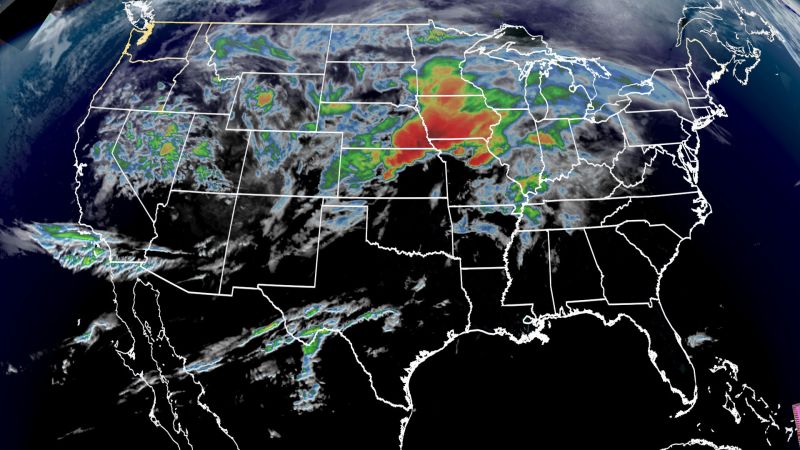
Intense thunderstorms are expected to unleash rounds of heavy rain that could bring dangerous flooding to tens of millions of people in the central and eastern US this week. The system, which picked up in parts of the Central and Southern Plains overnight Tuesday, is expected to produce hail, wind damage and “significant, life-threatening flash flooding,” the National Weather Service said, with parts of north-central Oklahoma and south-central Kansas at the greatest risk early in the week. A tornado was reported on the ground northeast of Kanopolis Lake in Kansas Tuesday evening, with other possible tornados also reported in or near the city of Salina, according to CNN affiliate KWCH .
This sweeping storm comes on the heels of another system over the weekend that tore through the central US Sunday before taking over nearly the entire East Coast Monday. Seven people were killed. Some areas that were hit hard by the recent storm –– and the destructive storms in mid-March –– could yet again be in the path of the incoming system.

And with multiple rounds of heavy rain expected over the course of several days, there is potential for a once-in-a-lifetime flooding event this week. While April is typically when severe thunderstorm season starts to pick up pace, damaging weather has already unfolded more often than usual this year. Storms from January through March generated more than 3,200 reports of tornadoes, hail and damaging wind nationwide.
This week’s storm will add to that eye-popping total. Here’s what to expect: A multi-day severe weather event is taking shape A storm sweeping through the Rockies entered the Plains on Tuesday and gained momentum throughout the afternoon, forecasters said. A storm that began sweeping through the Rockies Tuesday continued to produce heavy downpours on its southern end while delivering snow in the Dakotas and Minnesota late Tuesday.
Though tornado warnings for portions of Kansas, Oklahoma and Texas were lifted late Tuesday night, a tornado watch will continue in those regions until Wednesday morning, according to the Storm Prediction Center . Some storms in Kansas and Oklahoma are expected to produce strong tornadoes EF2 or higher – capable of wind speeds between 111 and 135 mph – along with large hail the size of quarters to golf balls. Although Tuesday’s severe risk was largely confined to the Plains, the hazardous weather on Wednesday is expected to be more intense and reach a larger population.
A level 4 of 5 risk of severe thunderstorms is in place Wednesday for more than 4 million people in parts of the Mississippi Valley, while more expansive level 3 of 5 risk is in place for more than 42 million people from Texas to the Great Lakes, including Dallas, Chicago and Indianapolis. Level 4 implies the likelihood of long-lived, widespread and intense storms, whereas level 3 refers to numerous possible severe storms with a few of them intense, according to the weather service’s categories . Thunderstorms in the Midwest could remain severe after sunrise, but how they behave during the first few hours of daylight will affect some of the region’s severe threats the rest of the day.
If Chicago, for example, has stormy weather that lingers past the morning hours, it could prevent severe thunderstorms from forming over the city later in the day. But if the stormy weather clears out early, it will leave Chicago open to another, stronger round of thunderstorms starting in the late afternoon or evening. Some thunderstorms will also linger Wednesday morning in parts of Kansas and Missouri and will likely strengthen as they move east into the Mississippi Valley by the early afternoon.
Additional storms will develop by mid-afternoon in the Mississippi Valley, some of which could undergo “explosive” development, according to the Storm Prediction Center. By the evening, severe thunderstorms could stretch from Louisiana and Arkansas to as far north as Michigan. A few more storms could develop overnight in Texas.
Damaging wind gusts, hail and tornadoes are possible in any storm, but the greatest risk for tornadoes – some strong and long-lasting – will stretch from Arkansas to Indiana and Ohio. Nighttime tornadoes are nearly twice as likely to be deadly as those occurring during the day, a 2022 study found. The strongest storms could also dump up to baseball-sized hail in parts of the Mississippi Valley.
The storms will also deliver torrential rain that sets up a new, longer-lasting threat: flooding. This week could see ‘generational’ flooding A roadblock in the atmosphere caused by a stalled front will point a firehose of moisture from the Gulf right into the Mississippi and Ohio valleys and create a days-long flooding event this week. Forecasters predict heavy rain will set up serious and possible historic flooding in Arkansas, Missouri, Tennessee and Mississippi beginning late Wednesday.
A rare level 4 of 4 high risk of flooding rainfall is in place Thursday from extreme northeastern Arkansas through far western Kentucky. These high-risk flooding events are not to be underestimated as they are issued on fewer than 4% of days per year on average a year but are responsible for more than 80% of all flood-related damage and 36% of all flood-related deaths , Weather Prediction Center research shows. “This is an increasingly significant setup” with the potential for “high impacts and life-threatening flash flooding spanning the course of several days,” the center warned.
The threat of flooding will ramp up with each passing day starting Wednesday. The ground will get increasingly soaked until it becomes unable to absorb more and any rainfall after that point will set off dangerous flash flooding. Forecasters predict storms will work over the same areas repeatedly and could drop 2 to 6 inches of rain each day –– especially from Arkansas to Indiana.
By Saturday, areas caught repeatedly under the heaviest storms could end up with more than 15 inches of rain. The corridor where Arkansas, Missouri, Illinois, Kentucky and Tennessee meet are the most likely place for these extreme totals. “If we get anywhere near these amounts, a historic flash flooding event is likely,” the National Weather Service in Paducah, Kentucky, warned.
An entire spring’s worth of rain could fall in just four days in the hardest-hit locations. Paducah, for example, averages about 14.5 inches of rain from March to May.
The upcoming heavy rain event isn’t the first period of extreme rainfall this season and likely won’t be the last. Overwhelming rainfall is becoming more frequent in a warming world, as rising global temperatures push weather toward the extremes. Last week, more than half a year’s worth of rain fell in less than 48 hours and sent parts of South Texas underwater, forcing over 100 water rescues and leaving four dead.
.








_8.jpg?itok=wp-xhXRB)





